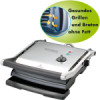Gastroback 42514 User Manual - Page 11
Tips For Best Results
 |
View all Gastroback 42514 manuals
Add to My Manuals
Save this manual to your list of manuals |
Page 11 highlights
2. Lift the Grill by the handle. The Angle Adjust non-slip feet are folded into sockets at the bottom of the base. Just, as required, fold out or fold in both feet until they snap into position. Thereafter, ensure that both feet are in the same position. Otherwise, the appliance will not stand stable. 3. Place the appliance on the desired working surface and unlock the lid (height control clip to the OPEN position). Thereafter, you can use the Grill. Tips for Best Results For best grilling results, use cuts which are thick enough to touch the grilling surfaces at the lid and bottom, when closing the lid (approx. 1 to 5.5 cm). Recommended Cuts: Beef Lamb Pork Sirloin (New York), Rump, Rib Eye (Scotch Filet), Filet Trim Lamb Leg Steaks, Filet, Eye of Loin, Cutlets, Diced Lamb Butterfly Loin Steaks, Spare Ribs, Leg Steaks, Filet, Diced Pork • Tougher cuts such as beef blade, topside steak, lamb forequarter or neck chops can be used. To tenderize these cuts, marinate them for a few hours or overnight in a marinade with wine or vinegar to help break down the connective tissue. • Add salt after cooking. Otherwise, the salt would dehydrate the meat, making it tough and dry. • If using a marinade recipe or pre-marinated meats from your meat retailer, drain excess marinade off and dab with kitchen paper before placing on the grilling surface. Some marinades contain high sugar levels, which can scorch on the grilling surface when cooked. • Do not overcook meat. Even pork is better served pink and juicy. • Do not pierce meat with a fork or cut meat while cooking. This will let the juices escape, resulting in a tougher and dry steak. • When cooking fish, use a flat heat-resistant plastic spatula to support the food. • Parboiling sausages can alleviate the need to pierce sausages before cooking. • It is recommended not to cook cuts with thick bones such as T-bone steaks. You should remove the bone before cooking. Grilling Guide Cooking temperatures and cooking times depend on your individual liking, as well as on thickness, type and consistency of your food. The following table holds some recommendations. If required, check your food for the desired consistency during cooking. • Select a low temperature (SANDWICH) for heating up food and cooking sandwiches. • Select medium temperatures for seafood and scallops. • Select high temperatures (SEAR) for meat and poultry. 33















